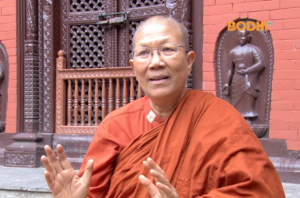“By logic, by reasoning or by eloquent words alone that act of going forth into homelessness can certainly not be argued or explained. But whoso sees this law, whoso sees this truth, no longer asks for proof. Quietly and with confidence he acts. What the world says about it, leaves him unconcerned.”
– “Going Forth: A Call to Buddhist Monkhood”, by Sumana Samanera. Access to Insight, 7 June 2010, http://www.accesstoinsight.org/lib/authors/sumana/wheel027.html. Retrieved on 28 December 2012.
The ritual of going forth, or pabbajja, remains a crucial element of global Buddhist culture. It was instituted by the historical Buddha himself, who in cutting away his princely hair, declared detachment from all worldly desires. Since then, cutting and shaving one’s facial hair completely has been the most visible indication of monastic life in all Buddhist traditions, apart from the robe. But unlike the immense diversity of colours and styles of Buddhist robes, shaved heads look more or less quite similar.
Shaving the head is not only for monks or nuns. In Asian cultures, it has been common for monastics to hold a short-term renunciation for members of the lay community. Anyone with the commitment and time can join. Throughout the course of the program, a layperson undergoes the lifestyle and practices of a monastic under a qualified monk who has been through it all before. Rising at 4am, meditation as the main activity of life, eating only up till late afternoon – short-term renunciation is the option for laypeople with secular responsibilities but want a taste of monastic experience. They must give up their usual commitments – family, career, monetary concerns, and leisure – and commit, like their teachers, to a life of more urgent cultivation and severer morality than they are used to.
While this may risk reducing the grave commitment of monk/nunhood into something of a tourist attraction, this concern is mitigated on two grounds. First, short-term renunciation is not some new fad or public relations campaign. It is deeply engrained in traditional Asian society, its legacy most obvious in South-East Asian countries like Thailand and Myanmar. Young boys are sent to monasteries at puberty as a demonstration of piety not only on behalf of the boy’s parents, but by the family to the monastic community. While there have been recent concerns that the numbers of boys sent to monasteries in Thailand has been declining, it remains one of the main pillars on which Buddhism’s modern relevance in South-East Asia rests.
Secondly, short-term renunciation allows laypeople to test the waters, so to speak, to caution the over-eager but also to encourage those quietly contemplating the ultimate step of giving up everything. Buddhist literature is replete with characters and personalities that shed rivers of tears for leaving their families and ‘the world’. The great stories of the tradition are not sentimental about the rigours of a life away from loved ones – indeed, while they exalt the life of the mendicant over the householder, they are very clear that the pull of household life often remains extremely strong for both laypeople and monks. Therefore, a short-term renunciation is the closest one can get to a trial-run before committing to the real journey. This vision, of course, is slightly too simplistic because it makes short-term renunciation sound like a marketing promotion. The renunciation should be done for its own sake – a worthwhile journey catered considerately for laypeople. And for this alone we are eternally grateful.
Keep an eye out for our upcoming photo album of the 2012 pabbajja at Wang Fat Ching She.



















